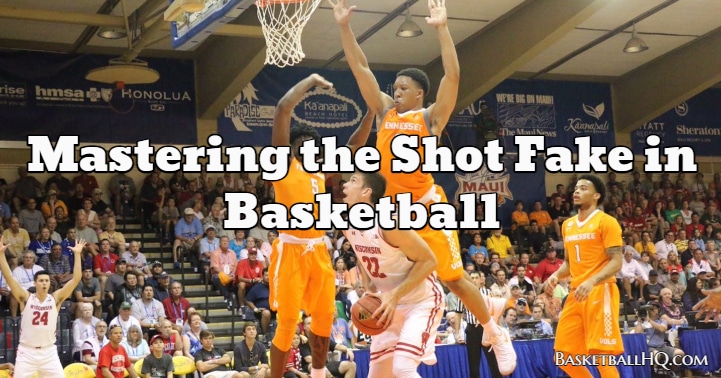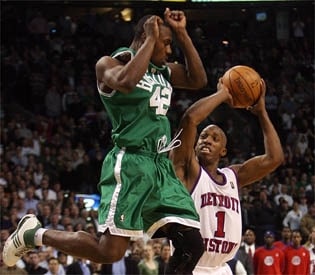
Chris Kreider contributed to this portion of the article.
One of the most overlooked characteristics of any good offensive basketball player is efficiency. Webster defines efficiency as “the ability to accomplish a job with a minimum expenditure of time and effort.” For any offensive player in basketball, the “job” at hand is to score.
A coach’s worst nightmare is the proverbial “volume scorer” who we all know may score a lot of points but usually doesn’t quite translate into the formula of winning basketball games.
This is where being efficient and creating easy scoring opportunities against a high-level defender with “minimal time and effort” becomes such a valuable commodity.
In my experience, I would put the shot fake in this unique group of “efficient weapons” that are often unintentionally disrespected by players and basketball coaches alike.
Often in our attempt as coaches to build up our individual offensive progression, we are quick to incorporate a shot fake into our basketball skill development workouts without taking the time to properly teach it and correct it.
If we do happen to initially teach the shot fake correctly, in an attempt to get a maximum number of repetitions, we sometimes allow bad habits to creep back in. By doing either one of these things, we limit and often eliminate the benefits of the shot fake. Like any other skill, we must pay attention to each detail and be sure that it is practiced and repeated perfectly every time.
Let’s cut to the chase. Great basketball shooters will always have the leg up when it comes to the shot fake. After all, the effectiveness of the shot fake is directly correlated to the threat of that player making shots.
So that goes without saying that anytime an identified “big-time shooter” is in his shooting range, anything that remotely looks like a shot fake has to be respected by the defender. This, in turn, means that if you want to improve your ability to shot fake, improve your ability to make shots! You have to be a threat!
By definition, a good shooter makes shots. Similarly, a good shot faker gets his or her defender out of their defensive stance. That is the mission and is ultimately the determining factor of whether or not the shot fake was successful. However, more goes into the execution of the shot fake that must be taught, repeated, and carried over to live-action.
So what does the perfect basketball shot fake look like?
1) Shows a shot and looks just like a shot except for the release!
The same footwork that goes into a perfect basketball shooting motion (knees bent, back straight, stationary feet, etc.) is required to sell a perfect shot fake! Having your eyes locked on the target and using your head and shoulders to simulate the shooting motion.
Selling your shot is critical in attempting to gain an angle or timing advantage on your defender as you begin your scoring move.
2) Is forceful!
The ultimate goal of a basketball shot fake is to force the defender to get out of their defensive stance. Raising the ball in a shooting motion anywhere from six to eight inches in a “shot-like” fashion and without any wasted movement is critical in attempting to sell the shot! The fake itself must be quick and executed at a game like speed in an attempt to look like a game-like shot!
3) Creates a scoring opportunity by forcing a decision to be made!
When executed properly, the defender is forced to react. It is important to remember that there is no limit on how many shot fakes can be used consecutively! Use multiple shot fakes if there is any confusion as you begin to read the defender. This will allow balance and comfort to be regained.
The offensive basketball player is always in control and must never allow themselves to be sped up by the defender. Once the shot fake gets the defender out of their stance, the reading begins. Once the read is made, having a progression of scoring moves off the dribble from this point is crucial. But remember to always work on keeping it simple and keep it to three dribbles or less!
4) Has an efficient 1st step!
The cardinal sin of a shot fake is to follow it with a “false step!” Attack the defender “shoulder-to-hip” and make an aggressive scoring move towards the basket. “Shoulder to hip” is the teaching point in an attempt to put the defender “in jail” and take them out of the play.
5) Passes the balance test by being able to execute the “Shot-Fake-Shot!”
If the defender stays on their feet and does not go for the shot fake, it is then up to the offensive player on how to proceed. Obviously, it is always about making the right basketball play, and in this case, it may be to simply reverse it or pass the ball to an open teammate.
However, if the defender takes a retreat step of any kind, the offensive player can execute the “Shot-Fake-Shot” (which is just like it sounds – shooting the ball immediately after the fake itself). After all, a shot fake is only considered perfect when it passes this final test.
The test is whether or not the offensive player can shoot the basketball immediately after executing the shot fake. Then and only then can the offensive player rest assured that the shot fake was executed properly. If they are off balance or have incorporated poor footwork into the fake, shooting the ball after the fake will prove to be very difficult.
Teaching the Shot Fake in Basketball
Coaching the Perfect Basketball Shot Fake
Teaching the art of the basketball shot fake is a crucial skill for all basketball coaches to have. One of the most popular triple threat basketball moves is the shot fake. While it is one of the most popular moves, it is quite uncommon for the move to be taught properly at the middle and high school levels. That is why I will break down the proper movements and some common mistakes when using the shot fake.
Common Basketball Shot Fake Mistakes
Staying low is highly important in mastering the shot fake in basketball. Staying low while you are stationary, using your shot fake, and while you are on the move from the shot fake is very important for having a successful shot fake. As my mentor, David Thorpe, commonly preaches, “The lower you are, the quicker you are!” If you are ever fortunate enough to watch him teach his students the proper shot fake, you will hear this several times throughout the course of the workout.
Most players do not have a low base or are not in an athletic position while performing this move. Basketball players often raise their hips as they move the ball upwards, causing them to not be in an explosive position where they can utilize their first step quickness to blow past a defender. After using your shot fake, you want your shoulder to be at the defender’s hips as you are blowing past them. The higher level you play at, the more the game is based on speed and quickness, and not staying low while shot faking defeats what we are preaching.
Correcting Common Basketball Shot Fake Mistakes
If your player has a problem staying low while being stationary and using a shot fake, then you want to have them start with a low base and in an athletic position. As they bring the ball upwards, put your hands on their shoulders, and put light pressure, forcing them to stay low. As they move the ball upwards towards their forehead, teach them to never raise their hips out of athletic position.
If your player has a problem staying low while moving off the dribble out of the shot fake, there are two simple ways to correct it as you are going through different basketball drills that will focus on the shot fake:
-
- After selling the shot fake, have the player use the hand that is not dribbling the basketball to touch the floor with their fingers as they make their first dribble towards the rim.
- Stand in front of the player with your arms out wide, slightly below shoulder level. After selling the shot fake, have the player go under your arms, keeping their shoulder at your hip level.
Mastering the Shot Fake in Basketball Conclusion
It is important that we, as basketball coaches, continue to break the game down into pieces for our players. Each piece and every detail of the game is crucial and can help our players become more efficient on both sides of the floor.
If it’s not perfect, fix it! Teach it. Drill it. Demand that it be executed perfectly! Don’t let another day go by allowing such a powerful offensive weapon to be disrespected in your basketball program!





3 Responses
To go forward you must have a push-off foot behind the center of gravity. The so-called ‘false step’ you refer to does exactly that. If you watch the demonstrator closely you will notice going to his right he steps up on the shot fake so his right foot is ahead of his left foot – this keeps his left is behind his center of gravity. However when he goes left, he does not bring his right past his left foot; it stays behind so he has it behind the center of gravity – this allows a more powerful push-off.
I teach defensive players to focus on body language and facial expressions. Through my research I’ve been able to identify a correlation between a shot fake and a real shot based on the focus of the eyes and facial expression.
I will admit you and I are out to help players develop, you offensively, me defensively. Lets continue to make players better
That is pretty interesting. Do you have a post or something on your research that I could look at? Thanks.